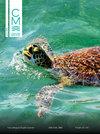墨西哥中部太平洋沿岸海扇锥的生态和种群特征
IF 0.7
4区 生物学
Q4 MARINE & FRESHWATER BIOLOGY
引用次数: 0
摘要
Conus属的西班牙海螺具有显著的生物医学意义,因为它们产生大量的毒素用于食物和防御,其中一种导致了一种新的药物,另一种正在开发用于临床和化妆品应用。然而,关于这组物种的基本知识很少,特别是在墨西哥。这项工作旨在确定墨西哥哈利斯科海岸蜗牛的相对丰度、空间分布、水深分布和对基质的偏好。为此,在覆盖潮间带、浅潮下带和深潮下带地层的13个海滩上,通过自由或自主潜水进行了直接搜索。相对密度为每100平方米0.021至0.418只蜗牛,平均每100平方米0.152只蜗牛。根据最近邻居指数的分析,该种群呈现出聚集型的空间分布。蜗牛的壳长在23.1毫米至52.2毫米之间,平均39.7毫米。Conus Princeps主要分布在潮间带和潮下带的地层中。较小的生物出现在较低的深度,而较大的生物分布在整个取样深度地层中。总体而言,可以观察到,随着深度的增加,蜗牛的数量减少了。根据对水下照片的分析,确定了蜗牛的偏好。王子们喜欢生活在覆盖着棕色藻类的岩石基质上。由于它们产生大量的毒素来喂养和自卫,因此Conus属的英国海洋蛇获得了显著的生物医学意义。其中一种毒素为新的药物开辟了道路,另两种毒素正在为临床和化妆品目的开发。然而,关于这组物种的基本知识很少,特别是在墨西哥。这项研究的目的是确定墨西哥哈利斯科南海岸蜗牛的相对丰度、空间分布、水深分布和栖息地偏好。为了实现这一目标,我们在13个海滩上通过浮潜或潜水进行了直接取样,覆盖了潮间带、浅亚带和深亚带。相对密度在每100平方米0.021至0.418条蛇之间,平均值为每100平方米0.152条蛇。根据最近的邻居指数,人口呈现出聚集的空间分布模式。蜗牛的壳长在23.1毫米至52.2毫米之间,平均壳长39.7毫米。圆锥王子主要分布在潮间带和浅亚带。较小的生物分布在较浅的深度,而较大的生物分布在整个取样的深度栖息地。总体而言,随着深度的增加,蜗牛的数量减少。根据水下摄影分析,我们确定Conus Princips Snails更喜欢覆盖着棕色海草的岩石底部栖息地。本文章由计算机程序翻译,如有差异,请以英文原文为准。
Ecological and population characteristics of the seashell Conus princeps on the Pacific coast of central Mexico
espanolLos caracoles marinos del genero Conus han adquirido notable importancia biomedica por el elevado numero de toxinas que producen para su alimentacion y defensa, de las cuales una ha dado lugar a un nuevo farmaco y otras mas se encuentran en desarrollo para aplicaciones clinicas y cosmeticas. No obstante, es poco el conocimiento basico que se tiene sobre este grupo de especies, en particular en Mexico. Con este trabajo se busca determinar la abundancia relativa, distribucion espacial, distribucion batimetrica y preferencia por el sustrato del caracol Conus princeps a lo largo de la costa de Jalisco (Mexico). Para ello, se realizaron busquedas directas por medio de buceo libre o autonomo en 13 playas cubriendo los estratos del intermareal, submareal somero y submareal profundo. La densidad relativa presento valores de entre 0.021 y 0.418 caracoles por 100 m2 y un promedio de 0.152 caracoles por 100 m2. La poblacion presento una distribucion espacial de tipo agregada segun los analisis del indice del vecino mas cercano. Se presentaron caracoles con conchas de entre los 23.1 mm y 52.2 mm de largo, con un promedio de 39.7 mm. Conus princeps se distribuyo principalmente en los estratos del intermareal y submareal somero. Los organismos de tallas menores se presentaron a bajas profundidades, mientras que los organismos de tallas mayores se distribuyeron en todo el estrato de profundidad muestreado. En general, se observo que con el aumento de la profundidad, disminuyo la abundancia de los caracoles. A partir del analisis de fotografias submarinas, se determino que existe una preferencia de los caracoles C. princeps por habitar en sustrato rocoso cubierto de algas pardas EnglishMarine snails of the genus Conus have acquired remarkable biomedical importance because of the high number of toxins they produce for feeding and self-defense. One of these toxins gave way to a new medication and two other are under development for clinical and cosmetic purposes. Nevertheless, there is little basic knowledge about this group of species, particularly in Mexico. This study aimed to determine the relative abundance, spatial distribution, bathymetric distribution, and habitat preference of the snail Conus princeps along the southern coast of Jalisco (Mexico). To achieve this goal, we conducted direct samplings by snorkeling or scuba diving at 13 beaches, covering the intertidal, shallow subtidal, and deep subtidal zones. Relative density was between 0.021 and 0.418 snails per 100 m2, with an average value of 0.152 snails per 100 m2. The population showed an aggregated spatial distribution pattern according to the nearest neighbor index. Snails had shells that measured between 23.1 mm and 52.2 mm long, with an average shell size of 39.7 mm. Conus princeps was mainly distributed in the intertidal and shallow subtidal zones. The smaller organisms were present at shallower depths, while the larger organisms were distributed throughout the sampled depth habitats. In general, snail abundance decreased as depth increased. From the underwater photography analysis, we determined that Conus princeps snails prefer rocky bottom habitats covered with brown seaweed.
求助全文
通过发布文献求助,成功后即可免费获取论文全文。
去求助
来源期刊

Ciencias Marinas
生物-海洋与淡水生物学
CiteScore
1.10
自引率
0.00%
发文量
9
审稿时长
>12 weeks
期刊介绍:
A bilingual open-access publication, Ciencias Marinas (CM) is an international peer-reviewed journal that contains original research findings in all areas of marine science. It is published quarterly by the Autonomous University of Baja California, Mexico, and all its contents are publicly available on our journal website. Though a limited number of copies are still printed, the journal is mainly distributed in its electronic format.
CM was conceived in 1973 as part of an academic project aimed to entice local researchers to publicly disclose their findings by adopting the culture of peer-review publishing. This academic project evolved into an international journal after accepting papers from researchers in the United States and, eventually, other parts of the world. Because of the diversity in authorship, CM issues were initially published in either Spanish or English, and occasionally in both languages. It was not until 1984 when CM included both language versions of all its contents, and it then became the fully bilingual journal it still is today. At CM we believe our inclusive format allows us not only to address a wider range of submissions from international authors but also to make published findings available to a wider international audience.
So whether you are looking for information on the redfish in Icelandic waters or the physical and biological properties of the Gulf of California, feel free to peruse CM contents. You may find them to provide source material for your research.
 求助内容:
求助内容: 应助结果提醒方式:
应助结果提醒方式:


